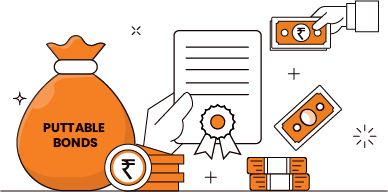What are Puttable Bonds?
A puttable bond is a type of bond that provides the bondholders with a right to sell the bond to the issuer before its maturity date. In other words, the bondholders can force the issuer to repurchase the security on specific dates before maturity. The repurchase price is set at the time of issue, which is usually at the face value of the bond.
Usually, the bondholders exercise the put option on specific events or conditions. Also, the embedded put option acts as an incentive for investors where they can purchase bonds at lower yields.
Furthermore, they provide investors with protection from a possible raising of interest rates. At the same time, the issuers can reduce their cost of debt by providing lower yields on bonds. Therefore, investors accept the lower yields in exchange for an option to exit the investment anytime, especially during unfavourable market conditions. This makes the puttable bonds yield lower returns than the callable bonds.
How Does a Puttable Bond Work?
A puttable bond is also known as a put bond or retraction bond. This bond comes with an embedded put option which gives the bondholders a right but not obligation to demand early repayment of principal from the issuer. Also, the bondholders can put back the bonds either once during the lifetime of the bond or on several different dates.
Example
Company ABC issues puttable bonds with a face value of Rs.100 with ten years maturity period. The coupon rate is 4.75%, and the current interest rate is 4%. The company provides the investors with a put option that can be exercised after the first five years.
After the first five years, if the interest rates have increased, investors have no incentive to hold the bond until maturity. Instead of holding the bonds, they can exercise the put option and receive the principal amount of investment. Also, investors can use these proceeds to invest in new bonds with higher coupon rates.
On the other hand, if the interest rates remain the same or decline, investors do not have an incentive to exercise the put option. They can likely hold the bonds until maturity to earn better yields.
The investors of puttable bonds have to accept lower yields than a common bond because of the embedded put option. Also, this can compensate the issuer for the additional risk where investors can redeem the bonds. Similarly, the price of the put bond is slightly higher than the common bonds.
Types of Puttable Bonds
The following are the most common types of puttable bonds.
Multi Maturity Bond
This type of puttable bond will have several maturity dates where the investor may or may not exercise the put option depending on the market scenario.
Option Tender Bond
They are a type of floating rate bond which is secured by municipal bonds or tax-exempt bonds. They grant the bondholder an option that requires the issuer to repurchase the bond at par before maturity. Thus, the bondholder loses the future coupon payments.
Explore Municipal Bonds in India
Variable Rate Demand Obligation (VRDO)
It is a type of put bond where the borrowed funds are payable on demand, and the interest rate is based on the prevailing market rates. Usually, they are long term municipal bonds.
How is a Puttable Bond Valued?
The value of a puttable bond differs from a common bond because of its put option feature. The put option affects the price of the bond because the investors have the right to sell the bond. They can force the issuers to redeem the bonds at the predetermined price. The following is the formula to determine the value of a puttable bond.
Price of a puttable bond = Price of regular bond + Price of a put option
Where,
Price of regular bond: Price of a straight or plain-vanilla bond with similar features of a puttable bond.
Price of a put option: The price for redeeming the bond before maturity, which is an additional cost to issuers.
Advantages and Disadvantages of Investing in a Puttable Bond?
The following are the advantages of investing in a puttable bond.
- Investing in a puttable bond has a low investment risk because of the embedded put option.
- The put option provides investors with an opportunity to liquidate bonds in case of unforeseen circumstances.
- Bonds with put options are an attractive investment in the secondary market as they offer extra security and safe exit options.
- Investors can add clauses in bond indenture to exercise the put option after a certain period or specific conditions.
- Issuers can borrow money at low coupon rates, especially when interest rates are expected to rise. In other words, the cost of financing is low.
- Issuers may also offer bond swaps if the investor wants to exercise the put option.
The following are the disadvantages of investing in a puttable bond
- These bonds offer lower yields than any other bonds because of the put option.
- If the interest rates are rising, the investor may force the issuer to liquidate the bond.
- Sometimes, the issuers may offer only a one-time window to investors to exercise the put option.
Discover More


















Show comments